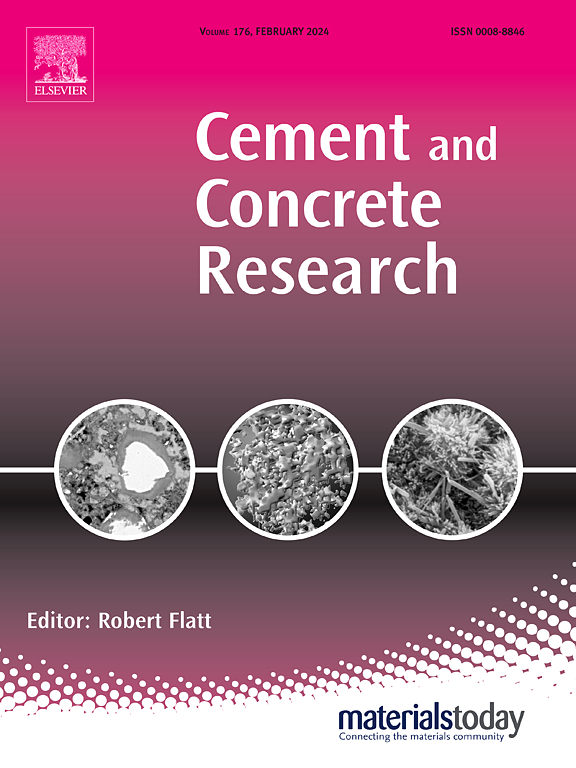Incorporation of boron into metakaolin-based geopolymers for radionuclide immobilisation and neutron capture potential
IF 10.9
1区 工程技术
Q1 CONSTRUCTION & BUILDING TECHNOLOGY
引用次数: 0
Abstract
Metakaolin-based geopolymers have attracted significant interest in decontaminating radioactive debris from the Fukushima nuclear accident. This study explored the incorporation of boron (B) into geopolymers using boric acid as the source, with the goal of developing B-enriched geopolymers for enhanced radionuclide immobilisation and neutron capture potential. The addition of boric acid lowered the pH of the alkali activator, reducing metakaolin solubility and impeding alkali-activated geopolymerisation. B formed an unstable BO4(xB, 4-xSi) structure with extra short-range Si tetrahedra in low-temperature curing conditions, making it prone to be leached out. High-temperature curing facilitated alkali-activated geopolymerisation, mitigating some negative effects of boric acid. It also promoted partial incorporation of BO4 into the framework, reducing leaching. Additionally, in acid-activated geopolymers, boric acid absorbed substantial reaction heat during the initial dealumination phase by reacting with PO4, thereby enhancing the overall geopolymerisation degree and increasing the relative content of near-Si terminal P and Al6 units. B could be incorporated into the framework by bonding with numerous Al-unsaturated Si tetrahedra to form a stable BO4(0B, 4Si) structure. Although B introduction slightly reduced the positive charge of the acid-activated geopolymer's structure, decreasing its capacity to immobilise anionic SeO32− through electrostatic adsorption, the decrease was negligible. Conversely, B introduction increased structural compactness, which improved Cs+ immobilisation through physical entrapment. Overall, the B-containing acid-activated geopolymer effectively incorporated B into the main matrix while maintaining radionuclide immobilisation capacity. This study provides valuable insights into the selection and incorporation mechanisms of the B-containing geopolymer matrix, contributing to effective strategies for radioactive waste disposal.


在偏高岭土聚合物中掺入硼用于放射性核素固定和中子捕获潜力
以偏高岭土为基础的地聚合物在福岛核事故放射性碎片的净化中引起了极大的兴趣。本研究以硼酸为源,探索将硼(B)掺入地聚合物中,目的是开发富硼地聚合物,以增强放射性核素固定和中子捕获潜力。硼酸的加入降低了碱活化剂的pH值,降低了偏高岭土的溶解度,阻碍了碱活化的地聚合。B在低温固化条件下形成不稳定的BO4(xB, 4-xSi)结构,具有额外的短距离Si四面体,容易被浸出。高温固化有利于碱活化的地聚合,减轻了硼酸的一些负面影响。它还促进BO4部分并入框架,减少浸出。此外,在酸活化的地聚合物中,硼酸通过与PO4反应,在初始脱铝阶段吸收了大量的反应热,从而提高了整体地聚合程度,增加了近si端P和Al6单元的相对含量。B可以通过与大量al -不饱和Si四面体结合,形成稳定的BO4(0B, 4Si)结构。虽然B的引入略微降低了酸活化地聚合物结构的正电荷,降低了其通过静电吸附固定阴离子SeO32−的能力,但这种降低可以忽略不计。相反,B的引入增加了结构致密性,从而通过物理夹持改善了Cs+的固定化。总体而言,含B的酸活化地聚合物有效地将B纳入主基质中,同时保持放射性核素固定能力。该研究为含b地聚合物基质的选择和结合机制提供了有价值的见解,有助于制定有效的放射性废物处理策略。
本文章由计算机程序翻译,如有差异,请以英文原文为准。
求助全文
约1分钟内获得全文
求助全文
来源期刊

Cement and Concrete Research
工程技术-材料科学:综合
CiteScore
20.90
自引率
12.30%
发文量
318
审稿时长
53 days
期刊介绍:
Cement and Concrete Research is dedicated to publishing top-notch research on the materials science and engineering of cement, cement composites, mortars, concrete, and related materials incorporating cement or other mineral binders. The journal prioritizes reporting significant findings in research on the properties and performance of cementitious materials. It also covers novel experimental techniques, the latest analytical and modeling methods, examination and diagnosis of actual cement and concrete structures, and the exploration of potential improvements in materials.
 求助内容:
求助内容: 应助结果提醒方式:
应助结果提醒方式:


